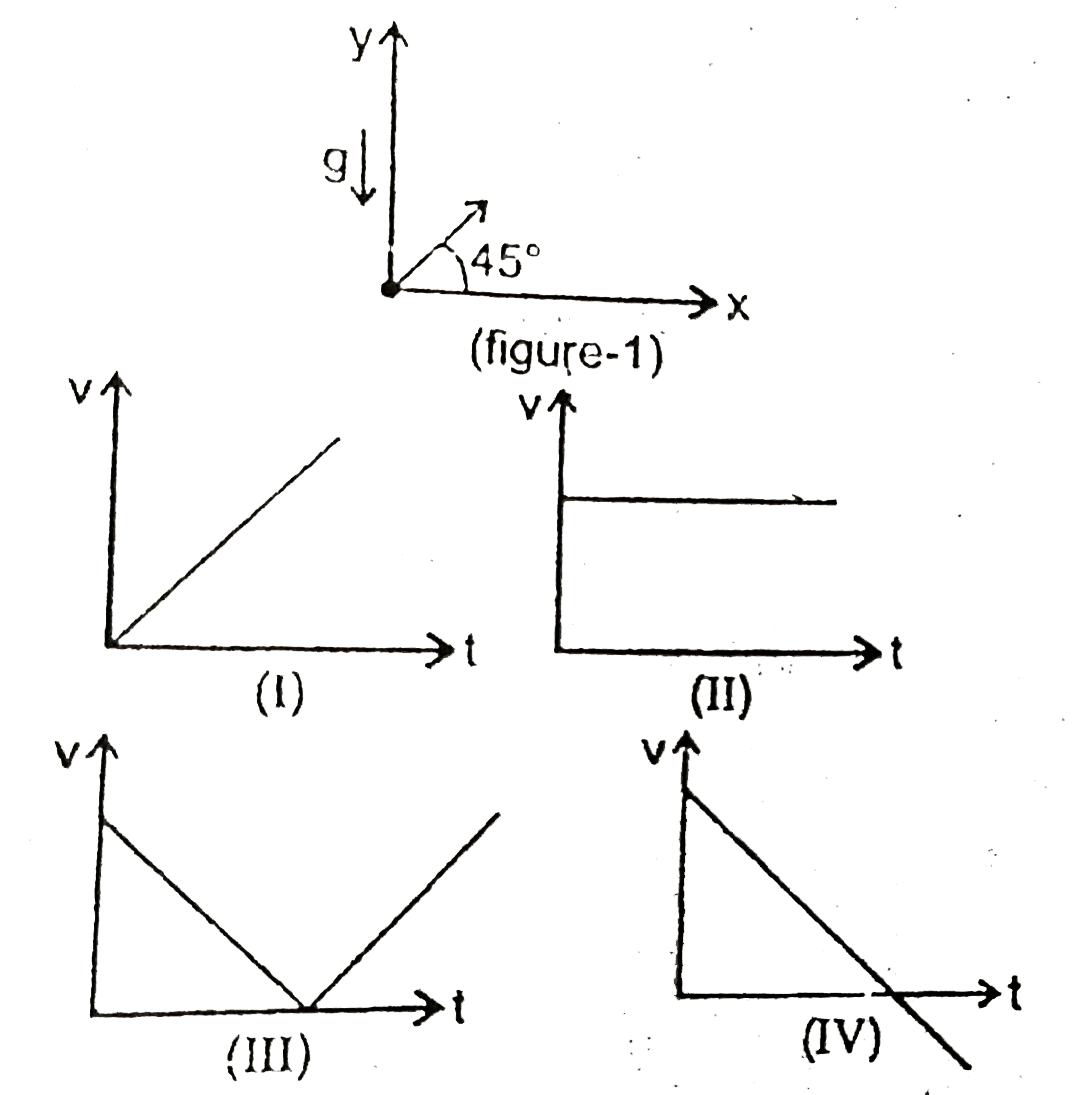A projectill is projected at an angle (α>45∘) with an initial velocity u. The time t, at which its magnitude of horizontal velocity will equal the magnitude of vertical velocity is :-
t=u(cosα+sinα)g
t=u(cosα−sinα)g
t=ug(sinα−cosα)
t=ug(sin2α−cos2α)
The correct Answer is:C
To solve the problem of finding the time t at which the magnitude of horizontal velocity equals the magnitude of vertical velocity for a projectile launched at an angle α with an initial velocity u, we can follow these steps:
1. Identify the Components of Initial Velocity:
The initial velocity u can be broken down into horizontal and vertical components:
- Horizontal component: ux=ucosα
- Vertical component: uy=usinα
2. Determine the Horizontal Velocity:
In projectile motion, the horizontal velocity remains constant throughout the motion because there is no horizontal acceleration. Thus:
vx=ucosα
3. Determine the Vertical Velocity:
The vertical velocity changes due to gravitational acceleration. The vertical velocity at any time t can be expressed as:
vy=uy−gt=usinα−gt
4. Set Horizontal Velocity Equal to Vertical Velocity:
We need to find the time t when the magnitudes of the horizontal and vertical velocities are equal:
ucosα=usinα−gt
5. Rearrange the Equation:
Rearranging the equation gives:
gt=usinα−ucosα
6. Factor Out u:
Factoring out u from the right side:
gt=u(sinα−cosα)
7. Solve for Time t:
Finally, we can solve for t:
t=u(sinα−cosα)g
Final Answer:
The time t at which the magnitude of horizontal velocity equals the magnitude of vertical velocity is:
t=u(sinα−cosα)g
The initial velocity u can be broken down into horizontal and vertical components:
- Horizontal component: ux=ucosα
- Vertical component: uy=usinα
In projectile motion, the horizontal velocity remains constant throughout the motion because there is no horizontal acceleration. Thus:
vx=ucosα
The vertical velocity changes due to gravitational acceleration. The vertical velocity at any time t can be expressed as:
vy=uy−gt=usinα−gt
We need to find the time t when the magnitudes of the horizontal and vertical velocities are equal:
ucosα=usinα−gt
Rearranging the equation gives:
gt=usinα−ucosα
Factoring out u from the right side:
gt=u(sinα−cosα)
Finally, we can solve for t:
t=u(sinα−cosα)g
The time t at which the magnitude of horizontal velocity equals the magnitude of vertical velocity is:
t=u(sinα−cosα)g
Topper's Solved these Questions
- KINEMATICSBOOK - ALLENCHAPTER - KINEMATICSEXERCISE - EXERCISE-02
57 Videos
- KINEMATICSBOOK - ALLENCHAPTER - KINEMATICSEXERCISE - EXERCISE-03
6 Videos
- KINEMATICSBOOK - ALLENCHAPTER - KINEMATICSEXERCISE - EXERCISE-2
89 Videos
- ERROR AND MEASUREMENTBOOK - ALLENCHAPTER - ERROR AND MEASUREMENTEXERCISE - Part-2(Exercise-2)(B)
22 Videos
- KINEMATICS (MOTION ALONG A STRAIGHT LINE AND MOTION IN A PLANE)BOOK - ALLENCHAPTER - KINEMATICS (MOTION ALONG A STRAIGHT LINE AND MOTION IN A PLANE)EXERCISE - BEGINNER S BOX-7
8 Videos
Similar Questions
A projectile is projected at an angle α with an initial velocity u. The time t, at which its horizontal velocity will equal the vertical velocity for the first time
View SolutionA particle is projected with a speed v and an angle θ to the horizontal. After a time t, the magnitude of the instantaneous velocity is equal to the magnitude of the average velocity from 0 to t. Find t.
View SolutionWhen a particle is projected at some angle with the horizontal, the path of the particle is parabolic. In the process the horizontal velocity remains constant but the magnitude of vertical velocity changes. At any instant during flight the acceleration of the particle remains g in vertically downward direction. During flight at any point the path of particle can be considered as a part of circle and radius of that circle is called the radius of curvature of the path
Consider that a particle is projected with velocity u=10m/s at an angle θ=60∘ with the horizontal and take value of g=10m/s2. Now answer the following questions.
The radius of curvature of path of particle at the instant when the velocity vector of the particle becomes perpendicular to initial velocity vector is
View SolutionA particle of mass m is projected at an angle α to the horizontal with an initial velocity u. The work done by gravity during the time it reaches its highest point is
View SolutionA particle is projected from ground at angle 45∘ with initial velocity 20(√2)m/s. Find
(a) change in velocity,
(b) magnitude of average velocity in a time interval from t=0 to t=3s.
View SolutionA particle is projected with velocity 50 m/s at an angle 60∘ with the horizontal from the ground. The time after which its velocity will make an angle 45∘ with the horizontal is
View SolutionA stone is projected at angle 45∘ with the horizontal (x- axis) as shown in figure. Four graphs representing either the magnitude of horizontal (vx) or magnitude of vertical (vy) component of velocity of stone w.r.t. time t are given below. Determine which of the following magnitude of velocity verseus time graph t, respestively for the stone during its motion.

View SolutionA particle is projected from horizontal making an angle of 53∘ with initial velocity 100ms−1. The time taken by the particle to make angle 45∘ from horizontal is
View SolutionA body is projected with an initial Velocity 20 m/s at 60° to the horizontal. Its velocity after 1 sec is
View SolutionFrom a point on the ground a particle is projected with initial velocity u, such that its horizontal range is maximum. The magnitude of average velocity during its ascent is
View Solution
